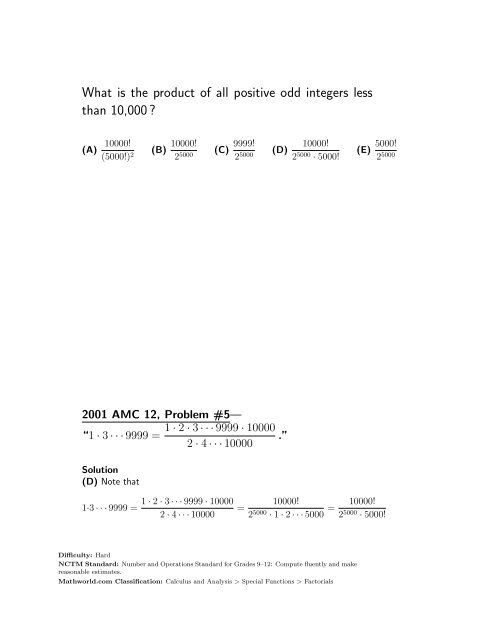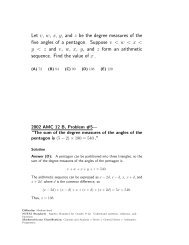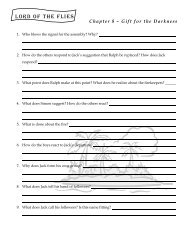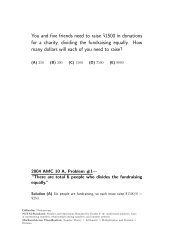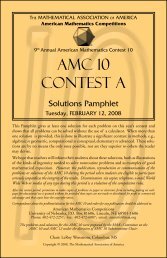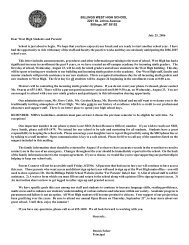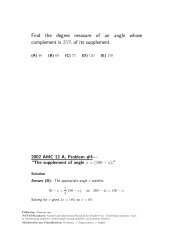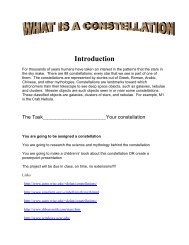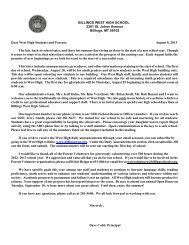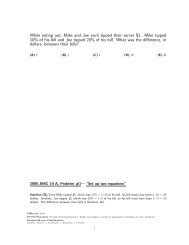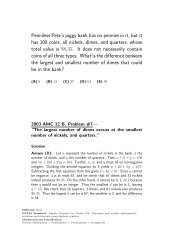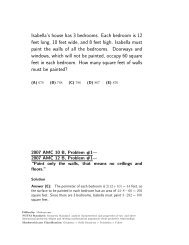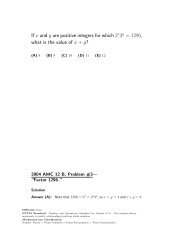What is the product of all positive odd integers less than 10,000 ?
What is the product of all positive odd integers less than 10,000 ?
What is the product of all positive odd integers less than 10,000 ?
Create successful ePaper yourself
Turn your PDF publications into a flip-book with our unique Google optimized e-Paper software.
<strong>What</strong> <strong>is</strong> <strong>the</strong> <strong>product</strong> <strong>of</strong> <strong>all</strong> <strong>positive</strong> <strong>odd</strong> <strong>integers</strong> <strong>less</strong><br />
<strong>than</strong> <strong>10</strong>,<strong>000</strong> ?<br />
(A) <strong>10</strong><strong>000</strong>!<br />
(5<strong>000</strong>!) 2 (B) <strong>10</strong><strong>000</strong>!<br />
2 5<strong>000</strong> (C) 9999!<br />
2 5<strong>000</strong> (D)<br />
<strong>10</strong><strong>000</strong>!<br />
2 5<strong>000</strong> · 5<strong>000</strong>!<br />
(E) 5<strong>000</strong>!<br />
2 5<strong>000</strong><br />
2001 AMC 12, Problem #5—<br />
1 · 2 · 3 · · · 9999 · <strong>10</strong><strong>000</strong><br />
“1 · 3 · · · 9999 = .”<br />
2 · 4 · · · <strong>10</strong><strong>000</strong><br />
Solution<br />
(D) Note that<br />
1·3 · · · 9999 =<br />
1 · 2 · 3 · · · 9999 · <strong>10</strong><strong>000</strong><br />
2 · 4 · · · <strong>10</strong><strong>000</strong><br />
=<br />
<strong>10</strong><strong>000</strong>!<br />
2 5<strong>000</strong> · 1 · 2 · · · 5<strong>000</strong> = <strong>10</strong><strong>000</strong>!<br />
2 5<strong>000</strong> · 5<strong>000</strong>!<br />
Difficulty: Hard<br />
NCTM Standard: Number and Operations Standard for Grades 9–12: Compute fluently and make<br />
reasonable estimates.<br />
Mathworld.com Classification: Calculus and Analys<strong>is</strong> > Special Functions > Factorials
Let f be a function sat<strong>is</strong>fying f(xy) = f(x)/y for <strong>all</strong><br />
<strong>positive</strong> real numbers x and y. If f(500) = 3, what <strong>is</strong><br />
<strong>the</strong> value <strong>of</strong> f(600) ?<br />
(A) 1 (B) 2 (C) 5 2<br />
(D) 3 (E) 18 5<br />
2001 AMC 12, Problem #9—<br />
“600 = 500 × 6 5 .”<br />
Solution<br />
(C) Note that<br />
For <strong>all</strong> <strong>positive</strong> x,<br />
f(600) = f(500 · 6<br />
5 ) = f(500) = 3<br />
6/5 6/5 = 5 2 .<br />
OR<br />
f(x) = f(1 · x) = f(1)<br />
x ,<br />
so xf(x) <strong>is</strong> <strong>the</strong> constant f(1). Therefore,<br />
600f(600) = 500f(500) = 500(3) = 1500,<br />
so f(600) = 1500<br />
<strong>the</strong> given conditions.<br />
600 = 5 2<br />
. Note. f(x) =<br />
1500<br />
x<br />
<strong>is</strong> <strong>the</strong> unique function sat<strong>is</strong>fying<br />
Difficulty: Hard<br />
NCTM Standard: Algebra Standard for Grades 9–12: Represent and analyze ma<strong>the</strong>matical<br />
situations and structures using algebraic symbols.<br />
Mathworld.com Classification: Calculus and Analys<strong>is</strong> > Functions
The parabola with equation y = ax 2 + bx + c and<br />
vertex (h, k) <strong>is</strong> reflected about <strong>the</strong> line y = k. Th<strong>is</strong><br />
results in <strong>the</strong> parabola with equation y = dx 2 +ex+f.<br />
Which <strong>of</strong> <strong>the</strong> following equals a + b + c + d + e + f ?<br />
(A) 2b (B) 2c (C) 2a + 2b (D) 2h (E) 2k<br />
2001 AMC 12, Problem #13—<br />
“The reflection <strong>of</strong> a point (x, y) about <strong>the</strong> line y = k <strong>is</strong><br />
(x, 2k − y) .”<br />
Solution<br />
(E) The equation <strong>of</strong> <strong>the</strong> first parabola can be written in <strong>the</strong> form<br />
y = a(x − h) 2 + k = ax 2 − 2axh + ah 2 + k,<br />
and <strong>the</strong> equation for <strong>the</strong> second (having <strong>the</strong> same shape and vertex, but<br />
opening in <strong>the</strong> opposite direction) can be written in <strong>the</strong> form<br />
Hence,<br />
y = −a(x − h) 2 + k = −ax 2 + 2axh − ah 2 + k.<br />
a+b+c+d+e+f = a+(−2ah)+(ah 2 +k)+(−a)+(2ah)+(−ah 2 +k) = 2k.<br />
OR<br />
The reflection <strong>of</strong> a point (x, y) about <strong>the</strong> line y = k <strong>is</strong> (x, 2k − y). Thus,<br />
<strong>the</strong> equation <strong>of</strong> <strong>the</strong> reflected parabola <strong>is</strong><br />
2k − y = ax 2 + bx + c, or equivalently, y = 2k − (ax 2 + bx + c).<br />
Hence a + b + c + d + e + f = 2k.<br />
Difficulty: Hard<br />
NCTM Standard: Geometry Standard for Grades 9–12: Apply transformations and use symmetry<br />
to analyze ma<strong>the</strong>matical situations.<br />
Mathworld.com Classification: Geometry > Transformations > Reflections
Given <strong>the</strong> nine-sided regular polygon<br />
A 1 A 2 A 3 A 4 A 5 A 6 A 7 A 8 A 9 , how many d<strong>is</strong>tinct<br />
equilateral triangles in <strong>the</strong> plane <strong>of</strong> <strong>the</strong> polygon have<br />
at least two vertices in <strong>the</strong> set {A 1 , A 2 , . . . A 9 } ?<br />
(A) 30 (B) 36 (C) 63 (D) 66 (E) 72<br />
2001 AMC 12, Problem #14—<br />
“Each <strong>of</strong> <strong>the</strong> ( 9<br />
2)<br />
≡ 9C2 = 36 pairs <strong>of</strong> vertices determines<br />
two equilateral triangles.”<br />
Solution<br />
(D) Each <strong>of</strong> <strong>the</strong> ( 9<br />
2)<br />
≡ 9C2 = 36 pairs <strong>of</strong> vertices determines two<br />
equilateral triangles, for a total <strong>of</strong> 72 triangles. However, <strong>the</strong> three triangles<br />
A 1 A 4 A 7 , A 2 A 5 A 8 , and A 3 A 6 A 9 are each counted 3 times, resulting in an<br />
overcount <strong>of</strong> 6. Thus, <strong>the</strong>re are 66 d<strong>is</strong>tinct equilateral triangles.<br />
Difficulty: Hard<br />
NCTM Standard: Algebra Standard for Grades 9–12: Understand patterns, relations, and<br />
functions.<br />
Mathworld.com Classification: Geometry > Plane Geometry > Triangles > Special Triangles ><br />
O<strong>the</strong>r Triangles > Triangle<br />
D<strong>is</strong>crete Ma<strong>the</strong>matics > Combinatorics > Permutations > Arrangement
An insect lives on <strong>the</strong> surface <strong>of</strong> a regular tetrahedron<br />
with edges <strong>of</strong> length 1. It w<strong>is</strong>hes to travel on <strong>the</strong><br />
surface <strong>of</strong> <strong>the</strong> tetrahedron from <strong>the</strong> midpoint <strong>of</strong> one<br />
edge to <strong>the</strong> midpoint <strong>of</strong> <strong>the</strong> opposite edge. <strong>What</strong><br />
<strong>is</strong> <strong>the</strong> length <strong>of</strong> <strong>the</strong> shortest such trip? (Note: Two<br />
edges <strong>of</strong> a tetrahedron are opposite if <strong>the</strong>y have no<br />
common endpoint.)<br />
(A) 1 2<br />
√<br />
3 (B) 1 (C)<br />
√<br />
2 (D)<br />
3<br />
2<br />
(E) 2<br />
2001 AMC 12, Problem #15—<br />
“Unfold <strong>the</strong> tetrahedron onto a plane.”<br />
Solution<br />
(B) Unfold <strong>the</strong> tetrahedron onto a plane. The two opposite-edge<br />
midpoints become <strong>the</strong> midpoints <strong>of</strong> opposite sides <strong>of</strong> a rhombus with<br />
sides <strong>of</strong> length 1, so are now 1 unit apart. Folding back to a<br />
tetrahedron does not change <strong>the</strong> d<strong>is</strong>tance and it remains minimal.<br />
Difficulty: Medium-hard<br />
NCTM Standard: Geometry Standard for Grades 9–12: Analyze character<strong>is</strong>tics and properties <strong>of</strong><br />
two- and three-dimensional geometric shapes and develop ma<strong>the</strong>matical arguments about geometric<br />
relationships.<br />
Mathworld.com Classification: Geometry > Solid Geometry > Polyhedra > Tetrahedra
A spider has one sock and one shoe for each <strong>of</strong> its eight<br />
legs. In how many different orders can <strong>the</strong> spider put<br />
on its socks and shoes, assuming that, on each leg,<br />
<strong>the</strong> sock must be put on before <strong>the</strong> shoe?<br />
(A) 8! (B) 2 8 8! (C) (8!) 2 (D) 16!<br />
2 8 (E) 16!<br />
2001 AMC 12, Problem #16—<br />
“There are 16! permutations <strong>of</strong> <strong>the</strong> sixteen<br />
symbols(both socks and shoes).”<br />
Solution<br />
(D) Number <strong>the</strong> spider’s legs from 1 through 8, and let a k and b k denote<br />
<strong>the</strong> sock and shoe that will go on leg k. A possible arrangement <strong>of</strong> <strong>the</strong><br />
socks and shoes <strong>is</strong> a permutation <strong>of</strong> <strong>the</strong> sixteen symbols a 1 , b 1 , . . . a 8 , b 8 ,<br />
in which a k precedes b k for 1 ≤ k ≤ 8. There are 16! permutations<br />
<strong>of</strong> <strong>the</strong> sixteen symbols, and a 1 precedes b 1 in exactly half <strong>of</strong> <strong>the</strong>se, or<br />
16!/2 permutations. Similarly, a 2 precedes b 2 in exactly half <strong>of</strong> those, or<br />
16!/2 2 permutations. Continuing, we can conclude that a k precedes b k for<br />
1 ≤ k ≤ 8 in exactly 16!/2 8 permutations.<br />
Difficulty: Hard<br />
NCTM Standard: Algebra Standard for Grades 9–12: Represent and analyze ma<strong>the</strong>matical<br />
situations and structures using algebraic symbols.<br />
Mathworld.com Classification: D<strong>is</strong>crete Ma<strong>the</strong>matics > Combinatorics > Permutations
A point P <strong>is</strong> selected at random from <strong>the</strong> interior <strong>of</strong> <strong>the</strong> pentagon<br />
with vertices A = (0, 2), B = (4, 0), C = (2π + 1, 0), D =<br />
(2π + 1, 4), and E = (0, 4). <strong>What</strong> <strong>is</strong> <strong>the</strong> probability that ∠AP B<br />
<strong>is</strong> obtuse?<br />
E<br />
A<br />
B<br />
D<br />
C<br />
(A) 1 5<br />
(B) 1 4<br />
(C) 5<br />
16<br />
(D) 3 8<br />
(E) 1 2<br />
2001 AMC 12, Problem #17—<br />
“Since ∠AP B = 90 ◦ if and only if P lies on <strong>the</strong><br />
semicircle with center (2, 1) and radius √ 5, <strong>the</strong> angel<br />
<strong>is</strong> obtuse if and only if <strong>the</strong> point P lies inside th<strong>is</strong><br />
semicircle.”<br />
Solution<br />
(C) Since ∠AP B = 90 ◦ if and only if P lies on <strong>the</strong> semicircle with E<br />
center (2, 1) and radius √ 5, <strong>the</strong> angel <strong>is</strong> obtuse if and only if <strong>the</strong><br />
point P lies inside th<strong>is</strong> semicircle. The semicircle lies entirely inside<br />
A<br />
<strong>the</strong> pentagon, since <strong>the</strong> d<strong>is</strong>tance, 3, from (2, 1) to DE <strong>is</strong> greater<br />
<strong>than</strong> <strong>the</strong> radius <strong>of</strong> <strong>the</strong> circle. Thus <strong>the</strong> probability that <strong>the</strong> nagle <strong>is</strong> O<br />
obtuse <strong>is</strong> <strong>the</strong> ratio <strong>of</strong> <strong>the</strong> area <strong>of</strong> <strong>the</strong> semicircle to <strong>the</strong> area <strong>of</strong> <strong>the</strong><br />
pentagon.<br />
Let O = (0, 0), A = (0, 2), B = (4, 0), C = (2π + 1, 0), D = (2π + 1, 4),<br />
and E = (0, 4). Then <strong>the</strong> area <strong>of</strong> <strong>the</strong> pentagon <strong>is</strong><br />
B<br />
D<br />
C<br />
[ABCDE] = [OCDE] − [OAB] = 4 · (2π + 1) − 1 (2 · 4) = 8π,<br />
2<br />
and <strong>the</strong> area <strong>of</strong> <strong>the</strong> semicircle <strong>is</strong><br />
The probability <strong>is</strong><br />
1<br />
2 π(√ 5) 2 = 5 2 π.<br />
5<br />
π 2<br />
8π = 5<br />
16 .<br />
Difficulty: Hard<br />
NCTM Standard: Geometry Standard for Grades 9–12: Analyze character<strong>is</strong>tics and properties <strong>of</strong><br />
two- and three-dimensional geometric shapes and develop ma<strong>the</strong>matical arguments about geometric<br />
relationships.<br />
Mathworld.com Classification: Geometry > Plane Geometry > Triangles > Special Triangles ><br />
O<strong>the</strong>r Triangles > Obtuse Triangle
A circle centered at A with a radius <strong>of</strong> 1 and<br />
a circle centered at B with a radius <strong>of</strong> 4 are<br />
extern<strong>all</strong>y tangent. A third circle <strong>is</strong> tangent<br />
to <strong>the</strong> first two and to one <strong>of</strong> <strong>the</strong>ir common<br />
external tangents as shown. The radius <strong>of</strong> <strong>the</strong><br />
third circle <strong>is</strong><br />
1<br />
A<br />
B<br />
4<br />
(A) 1 3<br />
(B) 2 5<br />
(C) 5<br />
12<br />
(D) 4 9<br />
(E) 1 2<br />
2001 AMC 12, Problem #18—<br />
“Connects <strong>the</strong> center <strong>of</strong> <strong>the</strong> circles, and explore <strong>the</strong><br />
relationships.”<br />
Solution<br />
(D) Let C be <strong>the</strong> intersection <strong>of</strong> <strong>the</strong> horizontal line through A<br />
and <strong>the</strong> vertical line through B. In right triangle ABC, we have<br />
BC = 3 and AB = 5, so AC = 4. Let x be <strong>the</strong> radius <strong>of</strong> <strong>the</strong><br />
third circle, and D be <strong>the</strong> center. Let E and F be <strong>the</strong> points <strong>of</strong><br />
intersection <strong>of</strong> <strong>the</strong> horizontal line through D with <strong>the</strong> vertical lines<br />
through B and A, respectively, as shown.<br />
In △BED we have BD = 4 + x and BE = 4 − x, so<br />
A<br />
F<br />
D<br />
B<br />
C<br />
E<br />
DE 2 = (4 + x) 2 − (4 − x) 2 = 16x,<br />
and DE = 4 √ x. In △ADF we have AD = 1 + x and AF = 1 − x, so<br />
F D 2 = (1 + x) 2 − (1 − x) 2 = 4x,<br />
and F D = 2 √ x. Hence,<br />
4 = AC = F D + DE = 2 √ x + 4 √ x = 6 √ x<br />
and √ x = 2, which implies x = 4.<br />
3 9<br />
Difficulty: Hard<br />
NCTM Standard: Geometry Standard for Grades 9–12: Analyze character<strong>is</strong>tics and properties <strong>of</strong><br />
two- and three-dimensional geometric shapes and develop ma<strong>the</strong>matical arguments about geometric<br />
relationships.<br />
Mathworld.com Classification: Geometry > Plane Geometry > Circles
The polynomial P (x) = x 3 + ax 2 + bx + c has <strong>the</strong><br />
property that <strong>the</strong> mean <strong>of</strong> its zeros, <strong>the</strong> <strong>product</strong> <strong>of</strong> its<br />
zeros, and <strong>the</strong> sum <strong>of</strong> its coefficients are <strong>all</strong> equal. If<br />
<strong>the</strong> y-intercept <strong>of</strong> <strong>the</strong> graph <strong>of</strong> y = P (x) <strong>is</strong> 2, what<br />
<strong>is</strong> b ?<br />
(A) −11 (B) −<strong>10</strong> (C) −9 (D) 1 (E) 5<br />
2001 AMC 12, Problem #19—<br />
“The sum and <strong>product</strong> <strong>of</strong> <strong>the</strong> zeros <strong>of</strong> P (x) are −a and<br />
−c, respectively.”<br />
Solution<br />
(A) The sum and <strong>product</strong> <strong>of</strong> <strong>the</strong> zeros <strong>of</strong> P (x) are −a and −c, respectively.<br />
Therefore,<br />
− a = −c = 1 + a + b + c.<br />
3<br />
Since c = P (0) <strong>is</strong> <strong>the</strong> y-intercept <strong>of</strong> y = P (x), it follows that c = 2. Thus<br />
a = 6 and b = −11 .<br />
Difficulty: Hard<br />
NCTM Standard: Algebra Standard for Grades 9–12: Use ma<strong>the</strong>matical models to represent and<br />
understand quantitative relationships.<br />
Mathworld.com Classification: Algebra > Polynomials
Points A = (3, 9), B = (1, 1), C = (5, 3), and D = (a, b) lie in <strong>the</strong> first<br />
quadrant and are <strong>the</strong> vertices <strong>of</strong> quadrilateral ABCD. The quadrilateral<br />
formed by joining <strong>the</strong> midpoints <strong>of</strong> AB, BC, CD, and DA <strong>is</strong> a square.<br />
<strong>What</strong> <strong>is</strong> <strong>the</strong> sum <strong>of</strong> <strong>the</strong> coordinates <strong>of</strong> point D ?<br />
(A) 7 (B) 9 (C) <strong>10</strong> (D) 12 (E) 16<br />
2001 AMC 12, Problem #20—<br />
“Sketch <strong>the</strong> figure and explore.”<br />
Solution<br />
(C) Let <strong>the</strong> midpoints <strong>of</strong> sides AB, BC, CD, and DA be denoted M,N,P ,and Q, respectively. Then<br />
M = (2, 5) and N = (3, 2). Since MN has slope −3, <strong>the</strong> slope <strong>of</strong> MQ must be 1/3, and MQ =<br />
MN = √ <strong>10</strong>. An equation for <strong>the</strong> line containing MQ <strong>is</strong> thus y − 5 = 1 (x − 2), or y = (x + 13)/3.<br />
3<br />
So Q has coordinates <strong>of</strong> <strong>the</strong> form (a, 1 3 (a + 13)). Since MQ = √ <strong>10</strong>, we have<br />
(a − 2) 2 + ( a + 13 − 5) 2 = <strong>10</strong><br />
3<br />
(a − 2) 2 + ( a − 2 ) 2 = <strong>10</strong><br />
3<br />
<strong>10</strong><br />
9 (a − 2)2 = <strong>10</strong><br />
(a − 2) 2 = 9<br />
a − 2 = ±3<br />
Since Q <strong>is</strong> in <strong>the</strong> first quadrant, a = 5 and Q = (5, 6). Since Q <strong>is</strong> <strong>the</strong> midpoint <strong>of</strong> AD and A = (3, 9),<br />
we have D = (7, 3), and 7 + 3 = <strong>10</strong>.<br />
OR<br />
Use translation vectors. As before, M = (2, 5) and N = (3, 2). So −−→ NM = 〈−1, 3〉. The vector −−→ MQ<br />
must have <strong>the</strong> same length as −−→ MN and be perpendicular to it, so −−→ MQ = 〈3, 1〉. Thus, Q = (5, 6). As<br />
before, D = (7, 3), and <strong>the</strong> answer <strong>is</strong> <strong>10</strong>.<br />
OR<br />
Each pair <strong>of</strong> opposite sides <strong>of</strong> <strong>the</strong> square are par<strong>all</strong>el to a diagonal <strong>of</strong> ABCD, so <strong>the</strong> diagonals <strong>of</strong><br />
ABCD are perpendicular. Similarly, each pair <strong>of</strong> opposite sides <strong>of</strong> <strong>the</strong> square has length half that<br />
<strong>of</strong> a diagonal, so <strong>the</strong> diagonals <strong>of</strong> ABCD are congruent. Since <strong>the</strong> slope <strong>of</strong> AC <strong>is</strong> -3 and AC <strong>is</strong><br />
perpendicular to BD, we have<br />
Since AC = BD,<br />
b − 1<br />
a − 1 = 1 , so a − 1 = 3(b − 1).<br />
3<br />
40 = (a − 1) 2 + (b − 1) 2 = 9(b − 1) 2 + (b − 1) 2 = <strong>10</strong>(b − 1) 2 ,<br />
and since b <strong>is</strong> <strong>positive</strong>, b = 3 and a = 1 + 3(b − 1) = 7. So <strong>the</strong> answer <strong>is</strong> <strong>10</strong>.<br />
Difficulty: Hard<br />
NCTM Standard: Geometry Standard for Grades 9–12: Use Cartesian coordinates and o<strong>the</strong>r<br />
coordinate systems, such as navigational, polar, or spherical systems, to analyze geometric situations.<br />
Mathworld.com Classification: Geometry > Plane Geometry > Quadrilaterals<br />
Geometry > Plane Geometry > Squares
Four <strong>positive</strong> <strong>integers</strong> a, b,c, and d have a <strong>product</strong> <strong>of</strong><br />
8! and sat<strong>is</strong>fy<br />
<strong>What</strong> <strong>is</strong> a − d ?<br />
ab + a + b = 524,<br />
bc + b + c = 146, and<br />
cd + c + d = <strong>10</strong>4.<br />
(A) 4 (B) 6 (C) 8 (D) <strong>10</strong> (E) 12<br />
2001 AMC 12, Problem #21—<br />
“ab + a + b = (a + 1)(b + 1) − 1 .”<br />
Solution<br />
(D) Note that<br />
and<br />
(a + 1)(b + 1) = ab + a + b + 1 = 524 + 1 = 525 = 3 · 5 2 · 7,<br />
(b + 1)(c + 1) = bc + b + c + 1 = 146 + 1 = 147 = 3 · 7 2 .<br />
Since (a + 1)(b + 1) <strong>is</strong> a multiple <strong>of</strong> 25 and (b + 1)(c + 1) <strong>is</strong> not a multiple<br />
<strong>of</strong> 5, it follows that a + 1 must be a multiple <strong>of</strong> 25. Since a + 1 divides<br />
525, a <strong>is</strong> one <strong>of</strong> 24, 74, 174, or 524. Among <strong>the</strong>se only 24 <strong>is</strong> a div<strong>is</strong>or <strong>of</strong><br />
8!, so a = 24. Th<strong>is</strong> implies that b + 1 = 21, and b = 20. From th<strong>is</strong> it<br />
follows that c + 1 = 7 and c = 6. Fin<strong>all</strong>y, (c + 1)(d + 1) = <strong>10</strong>5 = 3 · 5 · 7,<br />
so d + 1 = 15 and d = 14. Therefore, a − d = 24 − 14 = <strong>10</strong> .<br />
Difficulty: Hard<br />
NCTM Standard: Algebra Standard for Grades 9–12: Represent and analyze ma<strong>the</strong>matical<br />
situations and structures using algebraic symbols.<br />
Mathworld.com Classification: Calculus and Analys<strong>is</strong> > Special Functions > Factorials
In rectangle ABCD, points F and G lie on<br />
AB so that AF = F G = GB and E <strong>is</strong> <strong>the</strong><br />
midpoint <strong>of</strong> DC. Also, AC intersects EF at<br />
H and EG at J. The area <strong>of</strong> rectangle ABCD<br />
<strong>is</strong> 70. Find <strong>the</strong> area <strong>of</strong> triangle EHJ .<br />
D E C<br />
J<br />
H<br />
A<br />
F G<br />
B<br />
(A) 5 2<br />
(B) 35<br />
12<br />
(C) 3 (D) 7 2<br />
(E) 35 8<br />
2001 AMC 12, Problem #22—<br />
“△AF H and △CEH are similar. △AGJ and △CEJ are<br />
similar.”<br />
Solution<br />
(C) The area <strong>of</strong> triangle EF G <strong>is</strong> (1/6)(70) = 35/3. Triangles AF H and<br />
CEH are similar, so 3/2 = EC/AF = EH/HF and EH/EF = 3/5.<br />
Triangles AGJ and CEJ are similar, so 3/4 = EC/AG = EJ/JG and<br />
EJ/EG = 3/7.<br />
D E C<br />
H<br />
J<br />
A<br />
F<br />
Since <strong>the</strong> areas <strong>of</strong> <strong>the</strong> triangles that have a common altitude are<br />
proportional to <strong>the</strong>ir bases, <strong>the</strong> ratio <strong>of</strong> <strong>the</strong> area <strong>of</strong> △EHJ to <strong>the</strong> area <strong>of</strong><br />
△EHG <strong>is</strong> 3/7, and <strong>the</strong> ratio <strong>of</strong> <strong>the</strong> area <strong>of</strong> △EHG to that <strong>of</strong> △EF G <strong>is</strong><br />
3/5. Therefore, <strong>the</strong> ratio <strong>of</strong> <strong>the</strong> area <strong>of</strong> △EHJ to <strong>the</strong> area <strong>of</strong> △EF G <strong>is</strong><br />
(3/5)(3/7) = 9/35. Thus, <strong>the</strong> area <strong>of</strong> △EHJ <strong>is</strong> (9/35)(35/3) = 3 .<br />
G<br />
B<br />
Difficulty: Hard<br />
NCTM Standard: Geometry Standard for Grades 9–12: Explore relationships (including<br />
congruence and similarity) among classes <strong>of</strong> two- and three-dimensional geometric objects, make<br />
and test conjectures about <strong>the</strong>m, and solve problems involving <strong>the</strong>m.<br />
Mathworld.com Classification: Geometry > Plane Geometry > Triangles > Special Triangles ><br />
O<strong>the</strong>r Triangles > Similar Triangle
A polynomial <strong>of</strong> degree four with leading coefficient<br />
1 and integer coefficients has two real zeros, both <strong>of</strong><br />
which are <strong>integers</strong>. Which <strong>of</strong> <strong>the</strong> following can also<br />
be a zero <strong>of</strong> <strong>the</strong> polynomial?<br />
(A) 1 + i√ 11<br />
2<br />
(B) 1 + i<br />
2<br />
(C) 1 2 + i (D) 1 + i 2<br />
(E) 1 + i√ 13<br />
2<br />
2001 AMC 12, Problem #23—<br />
“Imaginary root always come in pairs.”<br />
Solution<br />
(A) If r and s are <strong>the</strong> integer zeros, <strong>the</strong> polynomial can be written in <strong>the</strong><br />
form<br />
P (x) = (x − r)(x − s)(x 2 + αx + β).<br />
The coefficient <strong>of</strong> x 3 , α − (r + s), <strong>is</strong> an integer, so α <strong>is</strong> an integer. The<br />
coefficient <strong>of</strong> x 2 , β − α(r + s) + rs, <strong>is</strong> an integer, so β <strong>is</strong> also an integer.<br />
Applying <strong>the</strong> quadratic formula gives <strong>the</strong> remaining zeros as<br />
1<br />
2 (−α ± √ α 2 − 4β) = − α √<br />
4β − α<br />
2 ± i 2<br />
.<br />
2<br />
Answer choices (A), (B), (C), and (E) require that α = −1, which<br />
implies that <strong>the</strong> imaginary parts <strong>of</strong> <strong>the</strong> remaining zeros have <strong>the</strong> form<br />
± √ 4β − 1/2. Th<strong>is</strong> <strong>is</strong> true only for choice (A).<br />
Note that choice (D) <strong>is</strong> not possible since th<strong>is</strong> choice requires α = −2,<br />
which produces an imaginary part <strong>of</strong> <strong>the</strong> form √ β − 1, which cannot be<br />
1<br />
2 .<br />
Difficulty: Hard<br />
NCTM Standard: Algebra Standard for Grades 9–12: Represent and analyze ma<strong>the</strong>matical<br />
situations and structures using algebraic symbols.<br />
Mathworld.com Classification: Calculus and Analys<strong>is</strong> > Roots<br />
Algebra > Polynomials
In triangle ABC, ∠ABC = 45 ◦ . Point D <strong>is</strong> on<br />
BC so that 2 · BD = CD and ∠DAB = 15 ◦ .<br />
Find ∠ACB.<br />
B<br />
D<br />
C<br />
A<br />
(A) 54 ◦ (B) 60 ◦ (C) 72 ◦ (D) 75 ◦ (E) 90 ◦<br />
2001 AMC 12, Problem #24—<br />
“Let E be a point on AD such that CE <strong>is</strong> perpendicular<br />
to AD, and connect BE. Explore <strong>the</strong> new figure.”<br />
Solution<br />
(D) Let E be a point on AD such that CE <strong>is</strong> perpendicular to<br />
AD, and draw BE. Since ∠ADC <strong>is</strong> an exterior angle <strong>of</strong> △ADB<br />
it follows that<br />
∠ADC = ∠DAB + ∠ABD = 15 ◦ + 45 ◦ = 60 ◦ .<br />
B<br />
D<br />
E<br />
C<br />
A<br />
Thus, △CDE <strong>is</strong> a 30 ◦ − 60 ◦ − 90 ◦ triangle and DE = 1 CD = BD.<br />
2<br />
Hence, △BDE <strong>is</strong> <strong>is</strong>osceles and ∠EBD = ∠BED = 30 ◦ . But ∠ECB <strong>is</strong><br />
also equal to 30 ◦ and <strong>the</strong>refore △BEC <strong>is</strong> <strong>is</strong>osceles with BE = EC. On<br />
<strong>the</strong> o<strong>the</strong>r hand,<br />
∠ABE = ∠ABD − ∠EBD = 45 ◦ − 30 ◦ = 15 ◦ = ∠EAB.<br />
Thus, △ABE <strong>is</strong> <strong>is</strong>osceles with AE = BE. Hence AE = BE = EC. The<br />
right triangle AEC <strong>is</strong> also <strong>is</strong>osceles with ∠EAC = ∠ECA = 45 ◦ . Hence,<br />
∠ACB = ∠ECA + ∠ECD = 45 ◦ + 30 ◦ = 75 ◦ .<br />
Difficulty: Hard<br />
NCTM Standard: Geometry Standard for Grades 9–12: Analyze character<strong>is</strong>tics and properties <strong>of</strong><br />
two- and three-dimensional geometric shapes and develop ma<strong>the</strong>matical arguments about geometric<br />
relationships.<br />
Mathworld.com Classification: Geometry > Trigonometry > Angles > Exterior Angle<br />
Geometry > Plane Geometry > Triangles > Special Triangles > O<strong>the</strong>r Triangles
Consider sequences <strong>of</strong> <strong>positive</strong> real numbers <strong>of</strong> <strong>the</strong><br />
form x, 2<strong>000</strong>, y, . . ., in which every term after <strong>the</strong><br />
first <strong>is</strong> 1 <strong>less</strong> <strong>than</strong> <strong>the</strong> <strong>product</strong> <strong>of</strong> its two immediate<br />
neighbors. For how many different values <strong>of</strong> x does<br />
<strong>the</strong> term 2001 appear somewhere in <strong>the</strong> sequence?<br />
(A) 1 (B) 2 (C) 3 (D) 4 (E) more <strong>than</strong> 4<br />
2001 AMC 12, Problem #25—<br />
“If a, b, and c are three consecutive terms <strong>of</strong> such a<br />
sequence, <strong>the</strong>n ac − 1 = b, which can be rewritten as<br />
c = (1 + b)/a .”<br />
Solution<br />
(D) If a, b, and c are three consecutive terms <strong>of</strong> such a sequence, <strong>the</strong>n<br />
ac − 1 = b, which can be rewritten as c = (1 + b)/a. Applying th<strong>is</strong> rule<br />
recursively and simplifying yields<br />
. . . , a, b, 1 + b<br />
a<br />
, 1 + a + b<br />
ab<br />
, 1 + a , a, b, . . .<br />
b<br />
Th<strong>is</strong> shows that at most five different terms can appear in such a sequence.<br />
Moreover, <strong>the</strong> value <strong>of</strong> a <strong>is</strong> determined once <strong>the</strong> value 2<strong>000</strong> <strong>is</strong> assigned to<br />
b and <strong>the</strong> value 2001 <strong>is</strong> assigned to ano<strong>the</strong>r <strong>of</strong> <strong>the</strong> first five terms. Thus,<br />
<strong>the</strong>re are four such sequences that contain 2001 s a term, namely<br />
1<br />
2001, 2<strong>000</strong>, 1,<br />
<strong>10</strong>00 , <strong>10</strong>01<br />
<strong>10</strong>00 , 2001, . . . ,<br />
1, 2<strong>000</strong>, 2001, <strong>10</strong>01<br />
<strong>10</strong>00 , 1<br />
<strong>10</strong>00 , 1, . . . ,<br />
2001<br />
4001999 , 2<strong>000</strong>, 4001999, 2001, 2002<br />
4001999 , 2001<br />
4001999 , . . . , and<br />
2001<br />
4001999, 2<strong>000</strong>,<br />
4001999 , 2002<br />
, 2001, 4001999, . . . ,<br />
4001999<br />
2001<br />
respectively. The four values <strong>of</strong> x are 2001, 1, , and 4001999 .<br />
4001999<br />
Difficulty: Hard<br />
NCTM Standard: Algebra Standard for Grades 9–12: Understand patterns, relations, and<br />
functions.<br />
Mathworld.com Classification: Number Theory > Sequences


